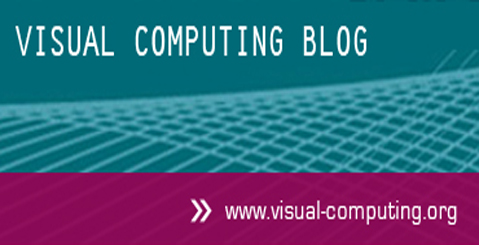B01 | Adaptive Self-Consistent Visualization
Our long-term goal targets the adaptation of the computer-based visualization process in order to make the visualization outcome consistent with the input data and the objectives of the visualization itself. Therefore, this project contributes to addressing the key challenge of obtaining reliable visualizations. Our model of self-consistency is formulated in a quantitative fashion: how much does the visualization result deviate from the intended result? The adaptation optimizes parameters of the visualization pipeline in order to minimize the deviation, including perceptual models, techniques from computer vision, efficient optimization methods and support for multi-objective optimization.
Research Questions
How can we build an efficient optimization framework for the adaptation of self-consistent visualization techniques?
What kind of quantitative models from perceptual psychology and computer vision literature can be used to optimize the encoding of direction information in 2D visualization?
Which quantitative models are useful for optimizing animated visualizations with moving patterns?
How can we adapt the visualization to maintain the structure of relative differences or derivatives from the input data in the form of contrast of the visualization images?
How can multi-objective optimization be used for overlaid visualization of multivariate data?
Fig. 1: Readability evaluation of node-link diagrams of trajectories using different link types, which encode the direction. Here, a repeating comet texture is used to indicate the direction. The comet texture is adapted to the human perception of direction. Furthermore, node splatting is used to indicate node locations and spatial node density.
Publications
- R. Jianu, N. Silva, N. Rodrigues, T. Blascheck, T. Schreck, and D. Weiskopf, “Gaze‐Aware Visualisation: Design Considerations and Research Agenda,” Computer Graphics Forum, 2025, doi: 10.1111/cgf.70097.
- D. Klötzl, T. Krake, M. Becher, M. Koch, D. Weiskopf, and K. Kurzhals, “NMF-Based Analysis of Mobile Eye-Tracking Data,” in Proceedings of the 2024 Symposium on Eye Tracking Research and Applications, 2024, pp. 1–9. doi: 10.1145/3649902.3653518.
- D. Weiskopf, “Bridging Quantitative and Qualitative Methods for Visualization Research: A Data/Semantics Perspective in Light of Advanced AI,” in 2024 IEEE Evaluation and Beyond - Methodological Approaches for Visualization (BELIV), IEEE, Ed., IEEE, 2024, pp. 119–128. doi: 10.1109/beliv64461.2024.00019.
- M. Koch, N. Pathmanathan, D. Weiskopf, and K. Kurzhals, “How Deep Is Your Gaze? Leveraging Distance in Image-Based Gaze Analysis,” in Proceedings of the 2024 Symposium on Eye Tracking Research and Applications (ETRA ’24), New York, NY, USA: ACM, 2024, pp. 1–7. doi: 10.1145/3649902.3653349.
- M. Koch, K. Kurzhals, M. Burch, and D. Weiskopf, “Visualization Psychology for Eye Tracking Evaluation,” in Visualization Psychology, D. Albers Szafir, R. Borgo, M. Chen, D. J. Edwards, B. Fisher, and L. Padilla, Eds., Cham: Springer International Publishing, 2023, pp. 243–260. doi: 10.1007/978-3-031-34738-2_10.
- K.-T. Chen et al., “Reading Strategies for Graph Visualizations That Wrap Around in Torus Topology,” in Proceedings of the 2023 Symposium on Eye Tracking Research and Applications, in ETRA ’23. New York, NY, USA: Association for Computing Machinery, 2023. doi: 10.1145/3588015.3589841.
- N. Rodrigues, C. Schulz, S. Döring, D. Baumgartner, T. Krake, and D. Weiskopf, “Relaxed Dot Plots: Faithful Visualization of Samples and Their Distribution,” IEEE Transactions on Visualization and Computer Graphics, vol. 29, Art. no. 1, Jan. 2023, doi: 10.1109/TVCG.2022.3209429.
- K.-T. Chen et al., “Gazealytics : A Unified and Flexible Visual Toolkit for Exploratory and Comparative Gaze Analysis,” in ETRA ’23 : Proceedings of the 2023 Symposium on Eye Tracking Research and Applications, Association for Computing Machinery, May 2023, pp. 1–7. doi: 10.1145/3588015.3589844.
- G. Richer, A. Pister, M. Abdelaal, J.-D. Fekete, M. Sedlmair, and D. Weiskopf, “Scalability in Visualization,” IEEE Transactions on Visualization and Computer Graphics, pp. 1–15, 2022.
- F. Chiossi et al., “Adapting visualizations and interfaces to the user,” it - Information Technology, vol. 64, pp. 133–143, 2022, doi: 10.1515/itit-2022-0035.
- F. Schreiber and D. Weiskopf, “Quantitative Visual Computing,” it - Information Technology, vol. 64, pp. 119–120, 2022, doi: 10.1515/itit-2022-0048.
- T. Krake, M. von Scheven, J. Gade, M. Abdelaal, D. Weiskopf, and M. Bischoff, “Efficient Update of Redundancy Matrices for Truss and Frame Structures,” Journal of Theoretical, Computational and Applied Mechanics, 2022, [Online]. Available: https://jtcam.episciences.org/10398
- T. Krake, D. Klötzl, B. Eberhardt, and D. Weiskopf, “Constrained Dynamic Mode Decomposition,” IEEE Transactions on Visualization and Computer Graphics, pp. 1–11, 2022, doi: 10.1109/tvcg.2022.3209437.
- T. Krake, A. Bruhn, B. Eberhardt, and D. Weiskopf, “Efficient and Robust Background Modeling with Dynamic Mode Decomposition,” Journal of Mathematical Imaging and Vision (2022), 2022, doi: 10.1007/s10851-022-01068-0.
- M. Koch, D. Weiskopf, and K. Kurzhals, “A Spiral into the Mind: Gaze Spiral Visualization for Mobile Eye Tracking,” Proceedings of the ACM on Computer Graphics and Interactive Techniques, vol. 5, Art. no. 2, May 2022, doi: 10.1145/3530795.
- N. Rodrigues, L. Shao, J. J. Yan, T. Schreck, and D. Weiskopf, “Eye Gaze on Scatterplot: Concept and First Results of Recommendations for Exploration of SPLOMs Using Implicit Data Selection,” in 2022 Symposium on Eye Tracking Research and Applications, in ETRA ’22. New York, NY, USA: Association for Computing Machinery, 2022, pp. 59:1–59:7. doi: 10.1145/3517031.3531165.
- K. Angerbauer et al., “Accessibility for Color Vision Deficiencies: Challenges and Findings of a Large Scale Study on Paper Figures,” in Proceedings of the 2022 CHI Conference on Human Factors in Computing Systems, in CHI ’22. New York, NY, USA: Association for Computing Machinery, 2022. doi: 10.1145/3491102.3502133.
- P. Schäfer, N. Rodrigues, D. Weiskopf, and S. Storandt, “Group Diagrams for Simplified Representation of Scanpaths,” in Proceedings of the ACM Symposium on Visual Information Communication and Interaction (VINCI), ACM, Aug. 2022. doi: 10.1145/3554944.3554971.
- L. Zhou, C. R. Johnson, and D. Weiskopf, “Data-Driven Space-Filling Curves,” IEEE Transactions on Visualization and Computer Graphics, vol. 27, Art. no. 2, 2021, doi: 10.1109/TVCG.2020.3030473.
- R. Bian et al., “Implicit Multidimensional Projection of Local Subspaces,” IEEE Transactions on Visualization and Computer Graphics, vol. 27, Art. no. 2, 2021, doi: 10.1109/TVCG.2020.3030368.
- A. Kumar, D. Mohanty, K. Kurzhals, F. Beck, D. Weiskopf, and K. Mueller, “Demo of the EyeSAC System for Visual Synchronization, Cleaning, and Annotation of Eye Movement Data,” in ACM Symposium on Eye Tracking Research and Applications, in ETRA ’20 Adjunct. New York, NY, USA: Association for Computing Machinery, 2020. doi: 10.1145/3379157.3391988.
- K. Kurzhals et al., “Visual Analytics and Annotation of Pervasive Eye Tracking Video,” in Proceedings of the Symposium on Eye Tracking Research & Applications (ETRA), ACM, 2020, pp. 16:1–16:9. doi: 10.1145/3379155.3391326.
- A. Kumar, P. Howlader, R. Garcia, D. Weiskopf, and K. Mueller, “Challenges in Interpretability of Neural Networks for Eye Movement Data,” in ACM Symposium on Eye Tracking Research and Applications, in ETRA ’20 Short Papers. New York, NY, USA: Association for Computing Machinery, 2020. doi: 10.1145/3379156.3391361.
- K. Kurzhals, M. Burch, and D. Weiskopf, “What We See and What We Get from Visualization: Eye Tracking Beyond Gaze Distributions and Scanpaths,” CoRR, 2020, [Online]. Available: https://arxiv.org/abs/2009.14515
- R. Garcia and D. Weiskopf, “Inner-Process Visualization of Hidden States in Recurrent Neural Networks,” in Proceedings of the 13th International Symposium on Visual Information Communication and Interaction, in VINCI ’20. New York, NY, USA: Association for Computing Machinery, 2020. doi: 10.1145/3430036.3430047.
- S. Öney et al., “Evaluation of Gaze Depth Estimation from Eye Tracking in Augmented Reality,” in Proceedings of the Symposium on Eye Tracking Research & Applications-Short Paper (ETRA-SP), ACM, 2020, pp. 49:1–49:5. doi: 10.1145/3379156.3391835.
- N. Pathmanathan et al., “Eye vs. Head: Comparing Gaze Methods for Interaction in Augmented Reality,” in Proceedings of the Symposium on Eye Tracking Research & Applications (ETRA), ACM, 2020, pp. 50:1–50:5. doi: 10.1145/3379156.3391829.
- N. Rodrigues, C. Schulz, A. Lhuillier, and D. Weiskopf, “Cluster-Flow Parallel Coordinates: Tracing Clusters Across Subspaces,” in Proceedings of the Graphics Interface Conference (GI) (forthcoming), Canadian Human-Computer Communications Society / Société canadienne du dialogue humain-machine, 2020, pp. 0:1–0:11. doi: 10.20380/GI2020.38.
- L. Zhou, M. Rivinius, C. R. Johnson, and D. Weiskopf, “Photographic High-Dynamic-Range Scalar Visualization,” IEEE Transactions on Visualization and Computer Graphics, vol. 26, Art. no. 6, 2020, doi: 10.1109/TVCG.2020.2970522.
- L. Merino, M. Schwarzl, M. Kraus, M. Sedlmair, D. Schmalstieg, and D. Weiskopf, “Evaluating Mixed and Augmented Reality: A Systematic Literature Review (2009 – 2019),” in IEEE International Symposium on Mixed and Augmented Reality (ISMAR), 2020. [Online]. Available: https://ieeexplore.ieee.org/abstract/document/9284762
- D. Weiskopf, “Vis4Vis: Visualization for (Empirical) Visualization Research,” in Foundations of Data Visualization, M. Chen, H. Hauser, P. Rheingans, and G. Scheuermann, Eds., Springer International Publishing, 2020, pp. 209–224. doi: 10.1007/978-3-030-34444-3_10.
- L. Zhou, R. Netzel, D. Weiskopf, and C. R. Johnson, “Spectral Visualization Sharpening,” in Proceedings of the ACM Symposium on Applied Perception (SAP), S. Neyret, E. Kokkinara, M. González-Franco, L. Hoyet, D. W. Cunningham, and J. Swidrak, Eds., ACM, 2019, pp. 18:1–18:9. doi: 10.1145/3343036.3343133.
- R. Netzel, N. Rodrigues, A. Haug, and D. Weiskopf, “Compensation of Simultaneous Orientation Contrast in Superimposed Textures,” in Proceedings of the Conference on Computer Vision, Imaging and Computer Graphics Theory and Applications (VISIGRAPP), A. Kerren, C. Hurter, and J. Braz, Eds., SciTePress, 2019, pp. 48–57. [Online]. Available: http://www.scitepress.org/DigitalLibrary/Link.aspx?doi=10.5220/0007356800480057
- V. Bruder et al., “Volume-Based Large Dynamic Graph Analysis Supported by Evolution Provenance,” Multimedia Tools and Applications, vol. 78, Art. no. 23, 2019, doi: 10.1007/s11042-019-07878-6.
- N. Silva et al., “Eye Tracking Support for Visual Analytics Systems: Foundations, Current Applications, and Research Challenges,” in Proceedings of the Symposium on Eye Tracking Research and Applications, ACM, 2019, pp. 11:1–11:9. doi: 10.1145/3314111.3319919.
- V. Bruder, K. Kurzhals, S. Frey, D. Weiskopf, and T. Ertl, “Space-Time Volume Visualization of Gaze and Stimulus,” in Proceedings of the Symposium on Eye Tracking Research & Applications (ETRA), K. Krejtz and B. Sharif, Eds., ACM, 2019, pp. 12:1–12:9. doi: 10.1145/3314111.3319812.
- C. Schulz, A. Zeyfang, M. van Garderen, H. Ben Lahmar, M. Herschel, and D. Weiskopf, “Simultaneous Visual Analysis of Multiple Software Hierarchies,” in Proceedings of the IEEE Working Conference on Software Visualization (VISSOFT), IEEE, 2018, pp. 87–95. [Online]. Available: https://ieeexplore.ieee.org/document/8530134/
- N. Rodrigues, R. Netzel, J. Spalink, and D. Weiskopf, “Multiscale Scanpath Visualization and Filtering,” in Proceedings of the Symposium on Eye Tracking and Visualization (ETVIS), L. L. Chuang, M. Burch, and K. Kurzhals, Eds., ACM, 2018, pp. 2:1–2:5. doi: 10.1145/3205929.3205931.
- M. Behrisch et al., “Quality Metrics for Information Visualization,” Computer Graphics Forum, vol. 37, Art. no. 3, 2018, doi: 10.1111/cgf.13446.
- N. Rodrigues and D. Weiskopf, “Nonlinear Dot Plots,” IEEE Transactions on Visualization and Computer Graphics, vol. 24, Art. no. 1, 2018, doi: 10.1109/TVCG.2017.2744018.
- C. Schulz, N. Rodrigues, K. Damarla, A. Henicke, and D. Weiskopf, “Visual Exploration of Mainframe Workloads,” in Proceedings of the SIGGRAPH Asia Symposium on Visualization, ACM, 2017, pp. 4:1–4:7. doi: 10.1145/3139295.3139312.
- K. Kurzhals, M. Stoll, A. Bruhn, and D. Weiskopf, “FlowBrush: Optical Flow Art,” in Symposium on Computational Aesthetics, Sketch-Based Interfaces and Modeling, and Non-Photorealistic Animation and Rendering (EXPRESSIVE, co-located with SIGGRAPH)., 2017, pp. 1:1–1:9. doi: 10.1145/3092912.3092914.
- K. Kurzhals, E. Çetinkaya, Y. Hu, W. Wang, and D. Weiskopf, “Close to the Action: Eye-Tracking Evaluation of Speaker-Following Subtitles,” in Proceedings of the 2017 CHI Conference on Human Factors in Computing Systems, ACM, Ed., 2017, pp. 6559–6568. doi: 10.1145/3025453.3025772.
- R. Netzel, J. Vuong, U. Engelke, S. I. O’Donoghue, D. Weiskopf, and J. Heinrich, “Comparative Eye-tracking Evaluation of Scatterplots and Parallel Coordinates,” Visual Informatics, vol. 1, Art. no. 2, 2017, doi: 10.1016/j.visinf.2017.11.001.
- N. Rodrigues et al., “Visualization of Time Series Data with Spatial Context: Communicating the Energy Production of Power Plants,” in Proceedings of the ACM Symposium on Visual Information Communication and Interaction (VINCI), 2017, pp. 37–44. doi: 10.1145/3105971.3105982.
- N. Rodrigues, M. Burch, L. Di Silvestro, and D. Weiskopf, “A Visual Analytics Approach for Word Relevances in Multiple Texts,” in Proceedings of the International Conference on Information Visualisation (IV), IEEE, 2017, pp. 1–7. [Online]. Available: https://ieeexplore.ieee.org/document/8107940
- D. Weiskopf, M. Burch, L. L. Chuang, B. Fischer, and A. Schmidt, Eye Tracking and Visualization: Foundations, Techniques, and Applications. Berlin, Heidelberg: Springer, 2016. [Online]. Available: https://www.springer.com/de/book/9783319470238
- K. Kurzhals, M. Hlawatsch, M. Burch, and D. Weiskopf, “Fixation-Image Charts,” in Proceedings of the Symposium on Eye Tracking Research & Applications (ETRA), ACM, Ed., ACM, 2016, pp. 11–18. doi: 10.1145/2857491.2857507.
- R. Netzel and D. Weiskopf, “Hilbert Attention Maps for Visualizing Spatiotemporal Gaze Data,” in Proceedings of the Symposium on Eye Tracking and Visualization (ETVIS), 2016, pp. 21–25. [Online]. Available: https://ieeexplore.ieee.org/stamp/stamp.jsp?arnumber=7851160
- A. Kumar, R. Netzel, M. Burch, D. Weiskopf, and K. Mueller, “Multi-Similarity Matrices of Eye Movement Data,” in Proceedings of the Symposium on Eye Tracking and Visualization (ETVIS), 2016, pp. 26–30. [Online]. Available: https://ieeexplore.ieee.org/document/7851161
- R. Netzel, M. Burch, and D. Weiskopf, “Interactive Scanpath-Oriented Annotation of Fixations,” Proceedings of the Ninth Biennial ACM Symposium on Eye Tracking Research & Applications, pp. 183–187, 2016, doi: 10.1145/2857491.2857498.
- R. Netzel, M. Burch, and D. Weiskopf, “User Performance and Reading Strategies for Metro Maps: An Eye Tracking Study,” Special Issue on Eye Tracking for Spatial Research in Spatial Cognition and Computation: An Interdisciplinary Journal, 2016, doi: 10.1080/13875868.2016.1226839.
- K. Kurzhals, M. Hlawatsch, F. Heimerl, M. Burch, T. Ertl, and D. Weiskopf, “Gaze Stripes: Image-Based Visualization of Eye Tracking Data,” IEEE Transactions on Visualization and Computer Graphics, vol. 22, Art. no. 1, 2016, doi: 10.1109/TVCG.2015.2468091.
- K. Kurzhals, B. Fisher, M. Burch, and D. Weiskopf, “Eye Tracking Evaluation of Visual Analytics,” Information Visualization, vol. 15, Art. no. 4, 2016, doi: 10.1177/1473871615609787.
- T. Blascheck, F. Beck, S. Baltes, T. Ertl, and D. Weiskopf, “Visual analysis and coding of data-rich user behavior,” in IEEE Conference on Visual Analytics Science and Technology, IEEE, 2016, pp. 141–150. doi: 10.1109/vast.2016.7883520.
- M. Burch, R. Woods, R. Netzel, and D. Weiskopf, “The Challenges of Designing Metro Maps,” Proceedings of the 11th Joint Conference on Computer Vision, Imaging and Computer Graphics Theory and Applications, 2016, doi: 10.5220/0005679601950202.
- K. Kurzhals, M. Burch, T. Pfeiffer, and D. Weiskopf, “Eye Tracking in Computer-based Visualization,” Computing in Science & Engineering, vol. 17, Art. no. 5, 2015, doi: 10.1109/MCSE.2015.93.
FOR SCIENTISTS
Projects
People
Publications
Graduate School
Equal Opportunity
FOR PUPILS
PRESS AND MEDIA
© SFB-TRR 161 | Quantitative Methods for Visual Computing | 2019.









